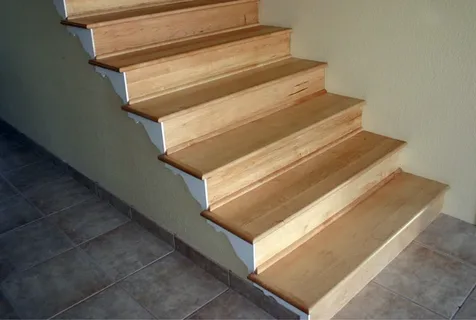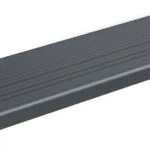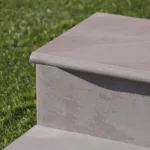Hardwood stair treads have long been a hallmark of classic home design. They are not only visually stunning but also incredibly durable, making them a popular choice for homeowners who want their stairs to be both practical and timeless. Whether you live in a century-old colonial, a craftsman bungalow, or even a modern farmhouse, wood stair treads bring warmth and authenticity that other materials often cannot match. Their natural beauty, rich grain, and ability to complement almost any interior style make them a choice worth considering for anyone renovating or building a home.
Why Hardwood Stair Treads Are Considered Classic
When people think of traditional or classic home design, hardwood often comes to mind. From flooring to cabinetry, hardwood has a reputation for quality and longevity. Hardwood stair treads follow the same tradition. Unlike alternatives made of composite materials or laminate coverings, solid wood stair treads have a depth and character that feels genuine and enduring. Over time, they even develop a subtle patina that adds charm rather than detracts from the look.
Classic homes appreciate details, and stairs are often one of the focal points when you enter. A staircase clad in hardwood stair treads creates a welcoming statement that reflects care and craftsmanship. Instead of being just a functional part of the home, it becomes a design feature that elevates the space.
Types of Wood Used for Stair Treads
There are many kinds of wood stair treads available, and the type of hardwood you choose significantly impacts the final look and durability. Some options are better suited for heavy foot traffic, while others offer unique aesthetics.
- Oak: A top choice for homeowners who want strength combined with a versatile style. Oak stair treads can be stained in countless shades and provide excellent wear resistance. You can read more about creating a timeless appeal with choosing oak stair treads.
- Maple: Known for its lighter tone, maple has a smooth grain that feels modern yet still fits seamlessly into classic interiors.
- Walnut: Rich, dark, and luxurious, walnut treads create a sophisticated look perfect for formal spaces.
- Hickory: A durable option known for its bold patterns and variation, which suits rustic-style homes beautifully.
- Cherry: Offers a deep, reddish tone that develops richness as it ages, delivering charm and warmth.
With so many options, the decision often depends on the design vision for your home as well as practical considerations like foot traffic and maintenance.
Solid Wood Stair Treads vs Engineered Wood
Homeowners often ask whether solid wood stair treads are worth the investment compared to engineered alternatives. The distinction is worth discussing.
- Solid Wood Stair Treads: Made from a single piece of wood, these are extremely durable and long-lasting. They can be refinished multiple times, which makes them ideal for decades of use. Solid wood stair treads remain the premium choice for homeowners who value quality and heritage.
- Engineered Wood Stair Treads: These are constructed with a veneer of hardwood on top of a plywood or composite core. While often more affordable and less prone to warping, they do not have the same longevity since refinishing options are limited.
In essence, if your goal is to stay true to classic home design and invest in durability, solid wood stair treads are superior.
Design Benefits of Hardwood Stair Treads
Hardwood stair treads do more than provide a safe surface to walk on. They actively shape the look and mood of your home.
- Timeless Appeal: Wood never truly goes out of style. A staircase crafted with hardwood stair treads looks elegant in 1920 and remains just as relevant today.
- Warmth and Comfort: The natural tones of wood bring coziness to interiors, making them especially appealing for family homes.
- Flexibility in Design: They can be customized to match existing flooring, stained to blend with furniture, or even left natural for a clean, airy feel.
- Value Addition: Replacing worn or carpeted stairs with hardwood stair treads can increase a home’s resale value since buyers recognize them as high-quality.
Practical Considerations for Installing Hardwood Stair Treads
While the beauty of wood stair treads is clear, practical aspects also play an important role. A staircase endures constant use, so material choices and installation methods must prioritize strength and safety.
- Thickness and Dimension: Standard hardwood stair treads are about one inch thick, but choosing thicker ones can lend a more substantial look and feel.
- Slip Resistance: Bare wood, although stunning, can be slippery. Consider adding non-slip finishes, or pairing with best non-slip stair treads for safety at home, especially if children or older adults live in the house.
- Finishing Options: Glossy finishes look elegant but may show scratches easily. Matte or satin finishes tend to balance beauty and endurance.
- Maintenance Requirements: Routine care such as sweeping and occasional polishing preserves their appearance. Avoid harsh chemicals that could damage the wood grain.
Comparing Hardwood Stair Treads with Other Options
Some homeowners choose carpet stair treads or even rubber options based on specific needs. While each material has its merits, hardwood remains in a category of its own.
- Carpet Stair Treads: Great for comfort and noise reduction, but they lack the same long-term character of wood. If your household likes added softness, you might explore carpet stair treads to add comfort and style.
- Rubber Stair Treads: Practical for outdoor use and weather resistance, but not appropriate for classic interiors. Outdoor rubber stair treads are better suited for front steps or decks exposed to rain and snow.
- Laminate or Vinyl Covers: These may mimic the look of wood at a lower cost, but they cannot match the authenticity or longevity of hardwood stair treads.
Styling Hardwood Stair Treads to Match Your Home
When integrating hardwood stair treads into your space, consider how they will coordinate with the rest of your design. Your staircase is a functional route, but it is also a visible part of your home’s overall aesthetic.
- Color and Stain Choices: A darker stain can add drama to a staircase with light-colored walls, while a natural finish may brighten a hallway.
- Baluster and Railing Materials: Wood pairs beautifully with wrought iron spindles for a classic look, or simple square posts for a more modern twist.
- Mixing with Painted Risers: Pairing hardwood stair treads with white-painted risers creates a stunning contrast that feels timeless.
- Continuation of Flooring: Using the same hardwood species for both floors and stair treads creates a seamless flow from one level of the home to the next.
These styling choices contribute to a cohesive design and give staircases a sense of belonging within the house.
Caring for Hardwood Stair Treads Over Time
Durability is one of the strongest selling points of solid wood stair treads, but proper care will ensure longevity.
- Routine Cleaning: Use a damp mop or cloth, but never leave standing water on the wood.
- Protective Pads: Placing felt pads on furniture at the base or top of the stairs prevents scuff marks.
- Seasonal Adjustments: Wood naturally expands and contracts with humidity, so maintaining a stable interior climate helps preserve the material.
- Professional Refinishing: After a decade or more of heavy use, sanding and refinishing can restore the original beauty of the treads, essentially making them look like new again.
Cost Considerations
Hardwood stair treads are often more expensive upfront than other materials, but they bring inherent value. Homeowners should factor in not just the purchase price but also the long-term benefits. Unlike carpet that may need replacement every few years, wood stair treads maintain their appeal for decades if cared for. Moreover, they often increase resale value, offsetting the initial investment.
Why Choose Hardwood Stair Treads for Your Home
Choosing hardwood stair treads is not simply about following tradition. It is about creating a home that reflects warmth, quality, and craftsmanship. Solid wood stair treads appeal to homeowners seeking authenticity and durability. They balance function with design, ensuring that your staircase is safe, stable, and striking at the same time.
Whether paired with contrasting white risers for a crisp look, stained to match elegant hardwood floors, or chosen in rich walnut for a sophisticated aesthetic, hardwood stair treads provide versatility and timeless style. They are the sort of thoughtful detail that makes a house feel like a cherished home, with every step up the staircase becoming a reminder of quality and beauty.
By selecting hardwood stair treads, you invest not only in the structure of your staircase but also in the character of your entire home. Their timeless charm and lasting durability make them an enduring choice for classic home design.



